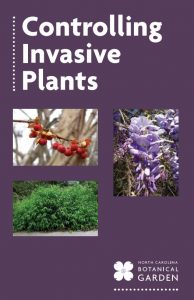Gardening with native plants restores lost connections between plants and wildlife.
A native plant grows naturally in a place rather than having been introduced by humans. Unlike many common ornamental plants, native plants have evolved with the local climate and wildlife and provide important food sources and habitats for native animals.
We have a rotating selection of native plants for sale, propagated right here at the North Carolina Botanical Garden. Didn’t find what you were looking for? Here are other native plant vendors we recommend.
Plants that are not native to the southeastern United States and that have become aggressive invaders of natural areas pose a serious threat to biological diversity. These invasive plants, such as Chinese wisteria, Japanese honeysuckle, autumn olive, and Japanese stiltgrass, should be removed whenever possible.
Native plant gardening
- List: Native Trees & Shrubs for Your Garden [PDF]
- List: Native Wildflowers, Ferns, & Grasses for Your Garden [PDF]
- List: Recommended Sources for Native Plants
- List: Book Recommendations for Seed Germination and Perennial Gardening
- Seed Growing Instructions and Germination Codes [PDF]
- Growing Carnivorous Plants [PDF]
Gardening for biodiversity
- Creating Your Pollinator Garden [PDF]
- Conservation Gardening [PDF]
- Bird-Friendly Native Plants (Audubon North Carolina)
- Creating Nesting & Overwintering Habitat for Pollinators and Other Beneficial Insects (Xerxes Society PDF)
Invasive plants to avoid
- Booklet: Controlling Invasive Plants [PDF]
- List: Invasive Exotic Species (NC Native Plant Society)
- Invasives 101 (NC Invasive Plant Council)
- Plant This Instead! Eco-friendly Alternatives to Harmful Ornamental Plants (Coastal Landscapes Initiative)
Edible Plants
Download our free Controlling Invasive Plants booklet!
Now in its third edition, this resource covers common invasive plants in the North Carolina Piedmont and the best ways to get rid of them.
Wildflowers of the Atlantic Southeast is an authoritative trail-side reference for hikers, naturalists, gardeners, and anyone wishing to learn more about our region’s diverse plants.
The guide, written by NCBG director Damon Waitt, Herbarium director Alan Weakley, and botanist and editor Laura Cotterman, features over 1,200 common wildflowers with photographs and range maps.
